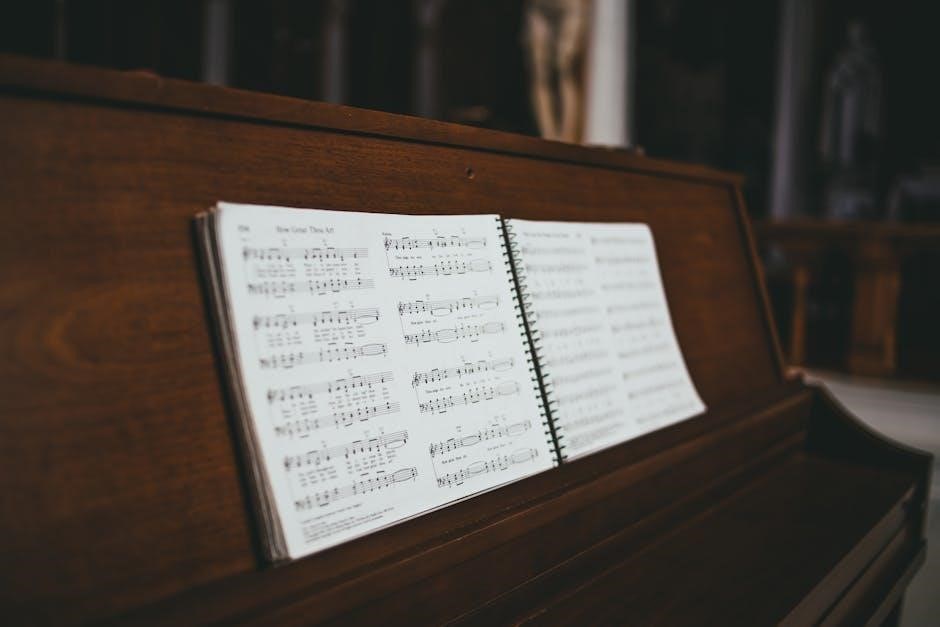“Do You Hear What I Hear?” is a timeless Christmas classic, with sheet music widely available in PDF format for piano, guitar, and voice arrangements. Its popularity endures, as seen in Carrie Underwood’s rendition and various transpositions, making it accessible for musicians of all levels. This format ensures portability and convenience for learning and performing, while platforms like MuseScore offer premium access for enhanced features. Explore and enjoy this beloved song with high-quality sheet music PDFs tailored to your needs.
Overview of the Song and Its Popularity
“Do You Hear What I Hear?” is a beloved Christmas song written by Gloria Shayne and Noel Regney, first recorded in 1962. Its timeless melody and heartfelt lyrics have made it a holiday classic, widely performed by artists like Carrie Underwood, whose version gained significant popularity. The song’s universal appeal lies in its ability to evoke emotions, blending spiritual themes with a festive atmosphere. Over the years, it has been covered by numerous artists, featured in films, and remains a staple in holiday playlists. Its enduring popularity is reflected in the high demand for its sheet music, particularly in PDF format, which offers versatility for musicians across various instruments and skill levels.
Importance of Sheet Music in Learning and Performing the Song
Sheet music is a vital tool for learning and performing “Do You Hear What I Hear?” as it provides precise notation, ensuring accuracy in melody, harmony, and rhythm. For musicians, it serves as a clear guide, allowing for effective practice and mastery of the song. Learners benefit from the structured format, which enhances their understanding of the composition. Additionally, sheet music fosters musical expression, enabling performers to interpret the piece in their own unique way. Its availability in PDF format further enhances accessibility, making it easier for musicians to practice and perform confidently, whether solo or in groups, ensuring a polished and heartfelt rendition every time.
Why PDF Format is Preferred for Sheet Music
The PDF format is highly preferred for sheet music due to its universal compatibility and high-quality display across all devices. It ensures that musical notation remains crisp and clear, whether viewed on a computer, tablet, or smartphone. PDFs are also easily sharable and printable, making them ideal for rehearsals and performances. Additionally, PDFs often include interactive features like bookmarks and search functions, enhancing the learning experience. Their portability allows musicians to access sheet music anywhere, and they can be easily transposed or adjusted to suit different instruments or vocal ranges. This versatility and convenience make PDFs the go-to choice for musicians seeking “Do You Hear What I Hear?” sheet music.
Sources for “Do You Hear What I Hear?” Sheet Music in PDF

Sources for “Do You Hear What I Hear?” Sheet Music in PDF
Official platforms like MuseScore and MusicNotes offer high-quality PDF sheet music. Additionally, free repositories and community-driven sites provide accessible arrangements, ensuring a wide range of options for musicians.
Official Platforms Like MuseScore and MusicNotes
Official platforms such as MuseScore and MusicNotes are trusted sources for high-quality PDF sheet music of “Do You Hear What I Hear?”. These platforms offer accurate and professionally arranged scores, ensuring a seamless learning and performing experience. With MuseScore, users can access premium memberships for full viewing access to scores, while MusicNotes provides transposable arrangements in various keys. Both platforms are known for their user-friendly interfaces, making it easy to download and print sheet music instantly. Additionally, they often feature Carrie Underwood’s version and other popular arrangements, catering to a wide range of musical preferences and skill levels. These official sources are ideal for musicians seeking reliable and legally accessible sheet music.
Free Sheet Music Websites and Repositories
Various websites provide free sheet music for “Do You Hear What I Hear?” in PDF format, offering convenient access for musicians. Platforms like MuseScore offer free access to select arrangements, while other repositories specialize in free sheet music downloads. These sites often include versions for piano, guitar, and voice, catering to different skill levels. Users should verify licensing terms to ensure legal use. While free options may lack premium features, they provide a cost-effective way to access and print sheet music. Exploring these repositories can help musicians find the perfect arrangement without subscription costs, making it easier to learn and perform this beloved song.
Community-Driven Platforms and User Contributions
Community-driven platforms play a significant role in sharing “Do You Hear What I Hear?” sheet music in PDF format. Websites like MuseScore allow users to upload and share their arrangements, fostering collaboration and diversity. These platforms often feature user-contributed scores, including unique transpositions and interpretations. For example, arrangements tailored for specific instruments or vocal ranges are commonly shared. This collaborative approach ensures a wide variety of versions are available, catering to different skill levels and preferences. Users can also interact, providing feedback and improving the quality of shared sheet music. Such platforms emphasize the importance of community involvement in preserving and adapting musical works, making them invaluable for musicians seeking personalized arrangements.

Features of “Do You Hear What I Hear?” Sheet Music
The sheet music offers versatile arrangements for piano, guitar, and voice, with transpositions for various keys and interactive, printable versions for easy access and performance.
Arrangements for Different Instruments (Piano, Guitar, Voice)
The sheet music for “Do You Hear What I Hear?” is available in diverse arrangements tailored for various instruments, including piano, guitar, and voice. Piano arrangements are particularly popular, offering both solo and accompaniment versions, while guitar versions include chords and strumming patterns for acoustic performances. Vocal arrangements are also widely accessible, with options for soloists and choirs. These arrangements cater to different skill levels, from beginners to advanced musicians, ensuring versatility and accessibility. Many platforms, such as MuseScore, provide transposable scores, allowing musicians to adjust keys to suit their preferences. This variety makes the song adaptable for numerous performances, whether intimate or grand, ensuring its timeless appeal across genres and instrumentation.
Transpositions and Key Adjustments for Versatility
Transpositions and key adjustments are essential features of “Do You Hear What I Hear?” sheet music, enabling musicians to customize the piece to suit their needs. Whether you’re a pianist, guitarist, or vocalist, the ability to transpose the music into different keys ensures compatibility with various instruments and vocal ranges. This versatility is particularly beneficial for performances requiring specific tunings or for adapting the song to different musical styles. Platforms like MuseScore offer transposable scores, allowing users to print and play the music in any key instantly. Such flexibility makes the sheet music accessible to a wide range of musicians, from professionals to hobbyists, fostering creative interpretations and ensuring the song remains adaptable and timeless.
Interactive and Printable Versions for Convenience
Interactive and printable versions of “Do You Hear What I Hear?” sheet music offer unparalleled convenience for musicians. Digital platforms provide interactive scores that allow users to transpose keys, adjust tempos, and even practice with accompaniment tracks. This interactivity enhances learning and performance preparation. Additionally, printable versions enable musicians to create physical copies, ideal for rehearsals and live performances. Many platforms, such as MuseScore, offer instant downloads in PDF format, ensuring quick access to high-quality sheet music. These features cater to diverse needs, from casual practice to professional engagements, making the music more accessible and user-friendly for everyone. The combination of interactivity and printability ensures a seamless musical experience.

How to Download and Print the Sheet Music
Visit trusted platforms like MuseScore or MusicNotes, search for “Do You Hear What I Hear?”, and download the PDF. Print instantly for convenient practice and performance.
Step-by-Step Guide to Accessing the PDF
To access the PDF of “Do You Hear What I Hear?” sheet music, visit platforms like MuseScore or MusicNotes. Search for the song, select your preferred arrangement, and review the preview. Log in or create an account if required. Purchase or download the PDF, ensuring you have the necessary permissions. Once downloaded, open the file using a PDF viewer or music software like MuseScore. Print the sheet music on standard paper for practice or performance. Some platforms offer transpositions or key adjustments, so verify the version matches your needs. Ensure compliance with copyright laws by using legally sourced PDFs for a seamless and lawful experience.
Subscription and Membership Benefits for Premium Access
Premium memberships on platforms like MuseScore offer unmatched benefits for accessing “Do You Hear What I Hear?” sheet music. Subscribers enjoy unlimited downloads, full access to premium scores, and interactive features like tempo adjustment and transposition. With a membership, you can stream official scores, ensuring high-quality sheet music. Additionally, premium users often receive exclusive content, early updates, and an ad-free experience; MuseScore Premium, for instance, allows offline access and multi-device compatibility, making it ideal for musicians on the go. Subscription plans vary, but they provide cost-effective solutions for regular users, offering significant value for those seeking extensive sheet music libraries and advanced tools for learning and performance.
Licensing and Copyright Information for Legal Use
When accessing “Do You Hear What I Hear?” sheet music, it’s essential to respect copyright laws. The song, written by Gloria Shayne and Noël Regney, is protected under copyright, requiring proper licensing for legal use. Platforms like MuseScore offer premium access through memberships, ensuring compliance with copyright regulations. Users must obtain licenses for printing, performing, or adapting the music, with permissions varying by publisher. Sharing or distributing sheet music without authorization violates copyright laws, potentially leading to legal consequences. Supporting artists and composers by purchasing or subscribing to licensed sheet music promotes fair compensation and encourages continued creativity in the music industry.

Popular Arrangements and Versions
Carrie Underwood’s powerful rendition and Christmas-themed arrangements are widely popular. The song is also available in piano solo and guitar chord versions, catering to diverse musical preferences and skills.
Carrie Underwood’s Version and Its Unique Style
Carrie Underwood’s rendition of “Do You Hear What I Hear?” stands out with its powerful vocals and emotional delivery, making it a fan favorite. Her version, arranged for Piano/Vocal/Chords, captures the song’s essence while adding a contemporary twist. The sheet music, available in PDF, features transposable keys, allowing musicians to adapt it to their range. Underwood’s interpretation blends traditional and modern elements, appealing to both holiday enthusiasts and music lovers. Platforms like MuseScore offer premium access to her arrangement, enabling seamless practice and performance. This version is a testament to the song’s versatility and enduring appeal, making it a must-have for festive playlists and musical repertoire.
Christmas and Holiday-Themed Arrangements
The sheet music for “Do You Hear What I Hear?” is widely popular during the Christmas season, with numerous holiday-themed arrangements available. These include SATB practice audio, lead sheets with lyrics, and transposable versions tailored for festive performances. The song’s timeless message and melodic beauty make it a staple in holiday playlists, with arrangements spanning 21 genres and 39 instruments. Platforms like MuseScore offer premium access to Official Scores, ensuring high-quality sheet music for seasonal concerts and gatherings. Whether for solo performances or group ensembles, the song’s adaptability shines through its diverse arrangements, making it a cherished part of holiday celebrations worldwide. Its enduring appeal ensures it remains a favorite for musicians and audiences alike during the Christmas season.
Instrument-Specific Versions (Piano Solo, Guitar Chords)
The sheet music for “Do You Hear What I Hear?” is available in instrument-specific versions, catering to pianists and guitarists. The piano solo arrangement is particularly popular, offering a beautiful balance of melody and harmony. Guitar versions include chord sheets, ideal for strumming or fingerpicking, and can be paired with vocal lyrics for a full performance. Both formats are transposable, allowing musicians to adjust keys for their preference or skill level. These versions are widely available in PDF, making them easy to download and print. Whether for a solo act or ensemble, these arrangements provide versatility and convenience, ensuring the song’s timeless appeal is accessible to all musicians. The clarity and portability of these scores make them a favorite among performers and learners alike.

Benefits of Using Sheet Music PDFs
Sheet music PDFs offer portability, accessibility, and cost-effectiveness. They can be easily downloaded and used across devices, making them ideal for musicians on the go. PDFs also provide customization options, such as transpositions and tempo adjustments, enhancing learning and performance flexibility. Additionally, they reduce the need for physical storage, saving space and resources. Overall, PDF sheet music is a practical and efficient choice for modern musicians, ensuring convenience and adaptability for various musical needs.
Portability and Accessibility Across Devices
Sheet music PDFs are highly portable, allowing musicians to access their music library across various devices like smartphones, tablets, and laptops. This convenience ensures that you can practice or perform “Do You Hear What I Hear?” anytime, anywhere, without the need for physical copies. Cloud storage integration enables seamless syncing, making your sheet music accessible on multiple devices. Additionally, PDFs are compatible with apps like MuseScore, which support interactive features. This portability is especially beneficial for musicians who travel or collaborate with others. It also reduces the clutter of physical sheets, making it easier to organize and retrieve your music. This accessibility ensures a smooth and flexible musical experience for all users.
Customization Options for Personalized Learning
Sheet music PDFs of “Do You Hear What I Hear?” offer extensive customization options, allowing musicians to tailor the music to their preferences and skill levels. With tools like MuseScore, users can transpose the key, adjust tempos, and modify arrangements to suit their needs. This flexibility is particularly useful for learners, enabling them to practice at their own pace. Additionally, interactive versions allow for real-time adjustments, making it easier to explore different interpretations of the song. These features ensure a personalized learning experience, catering to both beginners and advanced musicians. By customizing the sheet music, users can enhance their understanding and appreciation of the piece, making the learning process more engaging and effective.
Cost-Effective Solution for Musicians and Learners
Sheet music PDFs for “Do You Hear What I Hear?” provide an economical solution for musicians and learners. Many platforms offer free or low-cost downloads, making high-quality arrangements accessible without financial strain. Premium memberships on sites like MuseScore grant access to extensive libraries at a fraction of the cost of physical copies. Additionally, PDFs can be printed multiple times, reducing long-term expenses. This affordability ensures that learners and performers can explore and master the song without budget concerns, making it an ideal choice for educational and artistic purposes. The cost-effectiveness of PDF sheet music supports musicians of all levels in achieving their goals efficiently.

Tools and Software for Playing and Editing Sheet Music
MuseScore and similar software enable easy viewing and editing of “Do You Hear What I Hear?” sheet music. These tools support transposition, playback, and customization, aiding musicians in practice and performance. They also allow for seamless integration with various devices, ensuring convenience and efficiency for learners and performers alike. These platforms are essential for enhancing musical understanding and perfecting arrangements.

MuseScore and Similar Software for Viewing Scores
MuseScore is a powerful tool for viewing and interacting with “Do You Hear What I Hear?” sheet music. It allows users to open, view, and edit scores, with features like transposition and playback. The software supports PDF imports and exports, making it ideal for musicians who prefer digital formats. With a MuseScore Premium membership, users gain access to a vast library of official scores, including “Do You Hear What I Hear?” in high quality. Similar software, such as NoteFlight and Flat, also offers robust sheet music management, enabling seamless collaboration and performance. These platforms are essential for musicians seeking to enhance their practice and performance capabilities with digital tools.
Apps for Practicing and Performing with Sheet Music
Apps like MuseScore, forScore, and OnSong are invaluable for practicing and performing “Do You Hear What I Hear?”. These tools allow musicians to load sheet music PDFs, adjust tempos, and use metronomes for precise practice. Features such as annotation, transpose, and playback make them essential for refining performances. Additionally, apps like AirTurn enable hands-free page turning, enhancing live performances; These platforms support a variety of formats, including PDF, ensuring compatibility with downloaded sheet music. By leveraging these apps, musicians can streamline their practice routines and deliver polished performances of “Do You Hear What I Hear?” with ease and professionalism.
Technology for Transposing and Adjusting Sheet Music
Modern technology simplifies transposing and adjusting sheet music for “Do You Hear What I Hear?”. Software like MuseScore and Finale allows users to change keys, transpose scores, and customize arrangements. These tools enable musicians to adapt the sheet music to their vocal or instrumental range effortlessly. Additionally, platforms like MuseScore offer interactive features, letting users modify tempos and keys in real-time. Mobile apps such as forScore provide annotation and transpose capabilities, enhancing practice and performance. These technologies ensure that sheet music remains versatile and accessible, catering to diverse musical needs and preferences.

Tips for Learning and Playing “Do You Hear What I Hear?”
- Practice scales and arpeggios to build finger dexterity for piano arrangements.
- Use a metronome to maintain consistent tempo while playing.
- Break the song into sections for focused practice and mastery.
- Study sheet music thoroughly to understand chord progressions and melodies.
- Collaborate with fellow musicians for harmonious group performances.
Practicing Techniques for Mastering the Song
Mastering “Do You Hear What I Hear?” requires consistent practice and a structured approach. Start by breaking the song into manageable sections, focusing on challenging parts first. Use a metronome to maintain a steady tempo and improve timing. For pianists, practice scales and arpeggios to build finger dexterity. Vocalists should warm up with exercises to enhance pitch accuracy and control. Guitarists can benefit from fingerstyle techniques to achieve a soft, melodic sound; Utilize tools like MuseScore for interactive practice and to explore transpositions. Regularly review sheet music to refine dynamics and articulation. Collaborate with others for harmonious group performances and seek feedback to identify areas for improvement. With dedication and patience, you’ll master this timeless classic.
Using Sheet Music to Improve Musical Understanding
Sheet music is an invaluable tool for deepening your understanding of “Do You Hear What I Hear?”; By analyzing the notation, you can identify key signatures, dynamics, and tempo markings that define the song’s mood and structure. Pay attention to chord progressions and melody lines to grasp the harmonic foundation. For vocalists, lyrics and phrasing cues in the sheet music provide insight into storytelling and emotional delivery. Instrumentalists can study arrangements to understand how their part contributes to the overall piece. Interactive PDFs, available on platforms like MuseScore, allow you to explore transpositions and adjust keys, making it easier to tailor the music to your skill level and preferences. This enhances both learning and performance, ensuring a richer musical experience.
Collaboration and Performance Tips
Collaboration is key when performing “Do You Hear What I Hear?”. Ensure all musicians are on the same page by reviewing the sheet music together, discussing dynamics, and assigning parts based on individual strengths. Communicate clearly about tempo and phrasing to maintain unity. During performance, focus on balance and blend, especially between vocals and instruments. Encourage eye contact and expressive gestures to convey the song’s emotional depth. For group performances, consider using digital sheet music apps to share scores seamlessly and make real-time adjustments. Practice with a metronome to maintain consistency, and leave room for spontaneous moments to keep the performance engaging and heartfelt.

Legal and Ethical Considerations
Respect intellectual property by accessing “Do You Hear What I Hear?” sheet music through licensed platforms. Unauthorized sharing or distribution violates copyright laws and undermines artists’ rights.
Understanding Copyright Laws for Sheet Music
Respecting copyright laws is essential when using “Do You Hear What I Hear?” sheet music. Most arrangements are protected under intellectual property rights, requiring legal access. Downloading or sharing sheet music without proper licensing can lead to legal consequences. Platforms like MuseScore and MusicNotes offer licensed versions, ensuring compliance. Users must avoid unauthorized distribution or modification of copyrighted material. Supporting artists and composers through legal access promotes fairness and sustainability in the music industry. Always verify the source and licensing terms before using sheet music to ensure ethical and lawful usage.
Supporting Artists and Composers Through Legal Access
Accessing “Do You Hear What I Hear?” sheet music through legal platforms ensures fair compensation for artists and composers. Purchasing or downloading from authorized sources supports the creators and the music industry. Illegal sharing or downloading violates copyright laws and deprives artists of rightful earnings. Platforms like MuseScore and MusicNotes offer licensed versions, contributing to the sustainability of musical content. By choosing legal access, users promote ethical practices and help artists continue producing high-quality music. This support fosters creativity and ensures that future generations can enjoy timeless classics like “Do You Hear What I Hear?”.
Sharing and Distributing Sheet Music Responsibly
Responsible sharing of “Do You Hear What I Hear?” sheet music involves respecting copyright laws and avoiding unauthorized distribution. Sharing copyrighted material without permission can harm artists and composers by depriving them of fair compensation. Always use official platforms or purchase sheet music legally to ensure ethical practices. If you wish to share, consider directing others to legal sources or using samples provided by platforms like MuseScore. This approach supports the music industry and promotes the creation of new content. By sharing responsibly, you contribute to the sustainability of musical works and respect the rights of those who create them.
“Do You Hear What I Hear?” sheet music in PDF offers a convenient and high-quality way to enjoy this timeless classic. By using legal sources, musicians support artists and ensure sustainable access to musical works. Explore various arrangements, practice with interactive tools, and share responsibly to preserve the song’s legacy. Embrace the joy of music while respecting its creators, and let this beloved tune inspire your performances and learning journey.
Summing Up the Importance of Sheet Music PDFs
Sheet music PDFs for “Do You Hear What I Hear?” are indispensable for musicians and learners, offering portability, accessibility, and customization. They allow seamless transitions between devices, enabling practice anywhere. With adjustable keys and arrangements for various instruments, PDFs cater to diverse skill levels and preferences. Legal access through platforms like MuseScore ensures support for creators while providing high-quality, interactive, and printable versions. These features make sheet music PDFs a vital tool for mastering and enjoying this beloved song, blending tradition with modern convenience for all music enthusiasts.
Encouragement to Explore and Enjoy “Do You Hear What I Hear?”
“Do You Hear What I Hear?” is a timeless classic that invites musicians and music lovers to explore its rich harmonies and heartfelt lyrics. With sheet music PDFs readily available, enthusiasts can easily access arrangements for piano, guitar, or voice, catering to all skill levels. Carrie Underwood’s rendition offers a modern twist, while traditional versions preserve the song’s festive essence. Whether you’re practicing solo or performing with others, this song’s versatility ensures a rewarding experience. Embrace the joy of music by exploring different arrangements and sharing this beloved tune with others. Let the spirit of the season inspire you to create memorable moments through this iconic song.
Final Tips for Musicians and Music Enthusiasts
When exploring “Do You Hear What I Hear?”, musicians are encouraged to experiment with different arrangements and transpositions to find their perfect fit. Utilize platforms like MuseScore for premium access to high-quality scores and practice tools. Regular practice and a deep understanding of the song’s structure will enhance your performance. Collaborate with fellow musicians to create harmonious renditions, and consider exploring Carrie Underwood’s version for inspiration. Always ensure proper licensing and copyright adherence when using sheet music. Embrace the joy of learning and performing this timeless classic, and share its beauty with others to spread the festive spirit.
Leave a Reply
You must be logged in to post a comment.